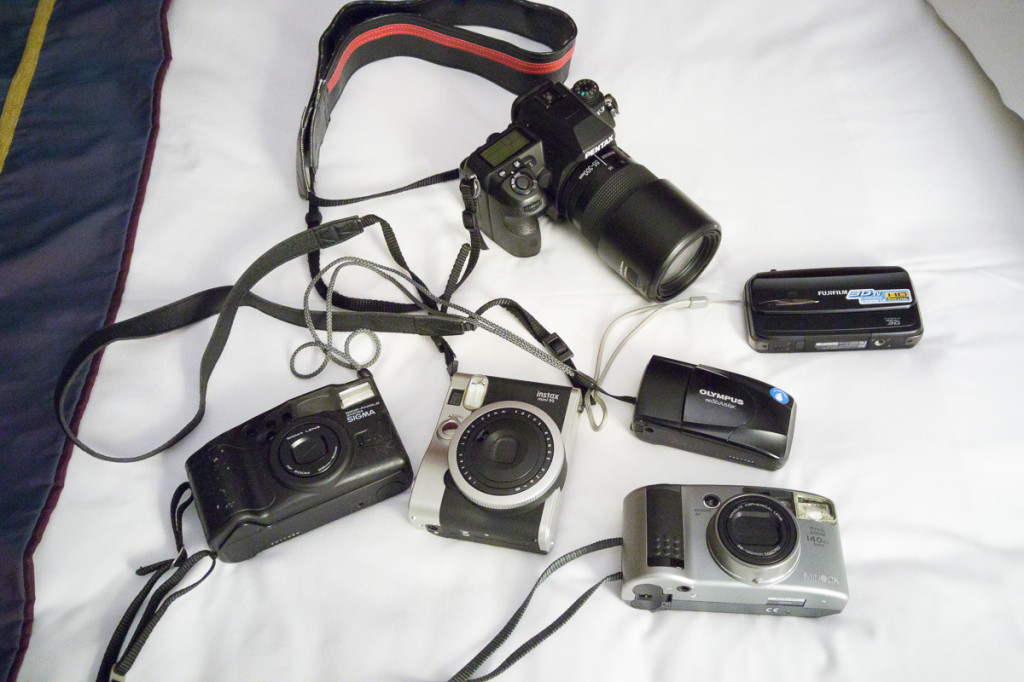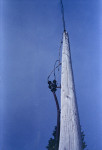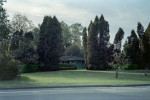Feb
29
2016

Style over function is what the Olympus LT-1 is. The association that is often made between something wrapped in leather and quality is broken by the plastic Lt-1. All this would be forgiven of course (by me) if it was a good camera but sorrowfully it is not. It has a 35mm f3.5 three element lens that is said to be the same as the Olympus Stylus and to be honest I have to go against the prevailing notions and say it isn’t that great. I know the Stylus (not to be confused with the Stylus Epic) is an important camera that sold in the millions but I find that wide open there is a lot of softness and aberrations in the corners with this lens. Also lacking in the functional department is the on/off switch, whereas the Stylus and the Epic turn on by sliding open their clamshells, here you need to pull the leather lens flap away and fiddle with the switch beside the lens on the side of the camera you are supposed to be pointing at something rather than looking at. And that flap is always threatening to include itself in your pictures doing what flaps do…flapping.
On the positive side of things it is a nice looking and feeling camera and it stands out as different, and sometimes isn’t that what you want? A camera that is a lifestyle choice rather than pure performance. If your using this camera you’ve already chosen to use film so it probably matches your handmade leather belt and satchel.
One thing about one camera: LT stands for leather tech and if you don’t like the notion of your camera being covered in an animal you can relax it is faux leather.
1 comment | tags: camera, film, olympus | posted in Cameras, Photography
Feb
25
2016

With the advent of smart phones and online sharing. The sheer number of images being captured poses an interesting dilemma, who is going to curate all that imagery and how much of it is transitory and how much should be kept. Just how many pictures is enough to document our lives and who are we documenting them for? The devaluation of pictures was brought home once again on seeing a large garbage bag full of slides at a flea market. An entire life’s photographic work at best to have a few images pulled out that interest those at hand the rest perhaps to be thrown away. This individual must have taken tens of thousands of Kodachrome slides over a lifetime only to have them wind up at an estate sale and then this indignity. I pulled a few out knowing that there was no way for me to go through them all or become the curator of someone else’s photographic oeuvre. These images are a sampling of what I chose but most of the other images I saw were of African safaris but who knows what artistic wonder may have been lurking at the bottom of this bag.
In one way or another this may very well be the fate of most images. Like a cell phone with thousands of images on it set aside and forgotten because the battery no longer works, is that not also a bag of slides on the ground? My daughter was looking through some images on my iPad and came across some amusing selfies she had taken with it, she then turned it towards me and said ‘why do you keep these?’ I should have said because I came from a time when every picture carried meaning. The meaning came from both their relative scarcity and the weight of significance we applied to them. Of course my response was ‘I don’t know’ because I don’t fully know. A further example of the loss of impact of a photo is the rise of Snapchat a social media platform that allows you to send pictures or video to individuals or small groups but has an ephemeral nature. The sent image is deleted after viewing and a predetermined amount of time. Work arounds aside the very notion of deleting an image after it has been seen is a real break from the semi permanence previously ascribed to them. In this case the images aren’t being used to create a document but more often as a way to amuse the recipient at that moment.
Once more photography has changed, fortunately most of the forms and practices that have come before remain so we can choose where in this photographic continuum we fit. For myself I will continue taking pictures with an eye towards documenting the world around me and storing them for some possible future I haven’t anticipated.
Along with these slides were old prints from the 1940’s of someone’s trip to visit glaciers in the Canadian Rockies a poignant argument for the preservation of images, at least some of them.
no comments | posted in Photography
Feb
20
2016

Pentax has released a new camera the K-1 and there are a lot of technological things to talk about with this camera but I wanted to focus on one particular aspect and that is its Pixel Shift technology and how that could be applied when capturing artwork or for still life’s. The Pentax K-1 has a 36.2 Megapixel sensor that produces an image that is 7360 pixels x 4912 pixels printed at 300DPI that would produce a print of 24″ x 16″ easily but could be printed larger at lower DPI. The sharper and more detailed the image the better it will handle the enlargement.
The K-1 pixel shift works by moving the sensor minute amounts taking four separate images that it combines internally. In this way it is able to capture the Red/Blue/Green components of each pixel rather than using algorithms to guess as nearly every other camera does including the K-1 in non pixel shift mode.

The result is a much more detailed image of the same size. Here is an example of the difference taken from two sample images from Pentax.

While the ability to use this feature in conditions where things are moving may improve its primary purpose and where it works best is with static subjects. This is why I make the assertion that it will be the best camera available for reproducing art work. There may be some very expensive Medium format alternatives for this type of work and in fact this may place this camera in direct competition with Pentax’s own 50 Mpixel 645Z medium format camera. At a suggested retail price of US $1799 and with the exceptional Pentax smc Pentax-D FA 100mm f/2.8 WR Macro Lens available for under $500 it leaves the 50Mpixel Canon 5Ds r at $3900 and the 36Mpixel Nikon D810 at $2800 costing considerably more without either offering this capability.
Here is a link to the Pentax sample images I used so you can see for yourself the entire image and what a difference Pixel shift can make. Pentax K-1 Sample Images
1 comment | posted in Cameras, Photography
Feb
19
2016

What happens when you use 25 year old Fuji Super HR 100 film in a camera of about the same age? It’s a trick question because the camera doesn’t matter but the film went through some weird colour transformations. I should mention that I exposed the film as if it were 50 ASA which was intended to help compensate for the loss of sensitivity over time of the film. No matter what you do though there is no getting past the fact that the film is irrevocably outdated. The blacks turned a toxic green and much of the contrast was lost, its fantastic. Perhaps its a little rebellion against the perfection others are striving to achieve with digital photography. Much as a painter laying down a stroke of thick paint can’t fully predict the result the uncertainty of film and especially expired film is a welcome diversion from high megapixels and just how much detail an image can capture before its heavily edited and shrunk down for posting to social media.

no comments | posted in Cameras, Photography
Feb
12
2016

For a point and shoot camera I really like the look of the Canon Classic 120. There is no doubt that they made an effort to evoke the feeling of rangefinders like the Canon QL17 and maybe even a little bit of the Demi from the mid 1960’s but it contains as advanced electronics as existed for point and shoot cameras in 1999. The autofocus is touted as being able to focus on subjects not positioned in the center of the frame and that it uses a hybrid active and passive autofocus. What this means is that the autofocus sensor is augmented in low light by a second system that sends out an infrared beam and determines the distance using this. This is what Canon had to say about it
Active/passive hybrid 3-point dual AI-AF. AF working range: 0.6m – infinity (normal mode), minimum focusing distance of 0.43 – 0.58m (close-up mode). Focusing point selection: 3-point AF, manual selection of center-point AF. AF modes: one-shot AF, servo AF mode. AF in-focus indicator: The green LED lights when subject is in-focus, or blinks as a too-close warning. Prefocus.
And translated into something a little more understandable
It focuses good. It focuses from arms length to those mountains in the distance when not set to macro and down to one and a half size twelve feet in macro. You can select the center focus point. It can focus on one point and lock while you press the shutter. It can continue to try to focus as you waste film in servo mode. A little green light comes on if it thinks its done good and flashes if its bad. You can point the camera at something press the shutter half way and hold it there and then recompose the picture with the same focus setting or as they concisely say ‘Prefocus’.
The cameras biggest drawbacks are its need for two expensive CR2 batteries and its slow f10.9 aperture at 120mm.
no comments | posted in Cameras, Photography
Feb
7
2016
 When I visit a place and I mean practically any place I like to take pictures no matter what the circumstances. This time I found myself spending 5 days in Harrison Hotsprings B.C. The trick was I was occupied from sunrise until long after sunset pretty much everyday as well as the draw of soaking in the warm water. Even under these circumstances a little lunch time walk here and a pre dinner one there coupled with a late night excursion produced a few images. After all if I didn’t have pictures how would I demonstrate I was ever there. These images are from my Pentax K-3 with the Pentax smc DA* 16-50mm f/2.8 ED AL (IF) SDM and the PENTAX-DA 50-200mm F4-5.6 ED WR lenses and also a few from my LG G4 cell phone. The film pictures will just have to wait.
When I visit a place and I mean practically any place I like to take pictures no matter what the circumstances. This time I found myself spending 5 days in Harrison Hotsprings B.C. The trick was I was occupied from sunrise until long after sunset pretty much everyday as well as the draw of soaking in the warm water. Even under these circumstances a little lunch time walk here and a pre dinner one there coupled with a late night excursion produced a few images. After all if I didn’t have pictures how would I demonstrate I was ever there. These images are from my Pentax K-3 with the Pentax smc DA* 16-50mm f/2.8 ED AL (IF) SDM and the PENTAX-DA 50-200mm F4-5.6 ED WR lenses and also a few from my LG G4 cell phone. The film pictures will just have to wait.
no comments | posted in Cameras, Photography































































































